July 2018 lunar eclipse
A total lunar eclipse occurred at the Moon's descending node on 27 July 2018. The Moon passed through the center of Earth's shadow in what was the first central lunar eclipse since 15 June 2011. It was also the second total lunar eclipse in 2018, after the one on 31 January. It was the longest total lunar eclipse of the 21st century, but not the longest in the 3rd millennium. The longest total lunar eclipse of the 3rd millennium will occur on May 12, 2264, lasting 106 minutes and 13.2 seconds.
| Total lunar eclipse 27 July 2018 | |
|---|---|
_(43696968392)_(cropped).jpg.webp) Oria, Italy, 21:09 UTC, end of totality | |
Ecliptic north up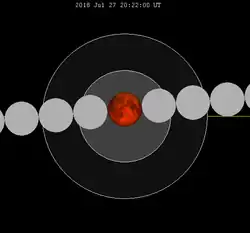 The moon passed through the center of the Earth's shadow | |
| Saros cycle | 129 (38 of 71) |
| Gamma | +0.1168 |
| Duration (hr:mn:sc) | |
| Totality | 1:42:57 |
| Partial | 3:54:32 |
| Penumbral | 6:13:48 |
| Contacts (UTC) | |
| P1 | 17:14:49 |
| U1 | 18:24:27 |
| U2 | 19:30:15 |
| Greatest | 20:21:44 |
| U3 | 21:13:12 |
| U4 | 22:19:00 |
| P4 | 23:28:39 |
The eclipse occurred when the Moon was near its maximum distance from Earth, which caused the Moon to appear smaller than normal (a phenomenon sometimes called a micromoon),[1][2] and to travel at its slowest speed in its orbit around Earth.[3] This was the longest total lunar eclipse that will occur in the 21st century, but not the longest in the 3rd millennium.[3] Totality lasted one hour and 42.955 minutes,[4][5][6][7] a period "just short of the theoretical limit of a lunar eclipse (one hour and 46.605 minutes)".[8] The Moon remained at least partially in Earth's shadow for four hours.[8]
This lunar eclipse coincided with Mars being nearly as close as possible to Earth, a concurrence that happens once every 25,000 years.[6]
A total lunar eclipse occurred on July 27, 2018. This was the longest total lunar eclipse exclusively in the 21st century, but the longest total lunar eclipse of the 3rd millennium will occur on May 12, 2264, lasting 106 minutes and 13.2 seconds, which will be the longest total lunar eclipse since 2000, and the longest one until 3107.
Background
A lunar eclipse occurs when the Moon passes within Earth's umbra (shadow). As the eclipse begins, Earth's shadow first darkens the Moon slightly. Then, the Earth's shadow begins to cover part of the Moon, typically turning it a dark red-brown color (the color can vary based on atmospheric conditions). The Moon appears to be reddish because of Rayleigh scattering (the same effect that causes sunsets to appear reddish and the daytime sky to appear blue) and the refraction of that light by Earth's atmosphere into its umbra.[9]
The Moon's brightness is exaggerated within the umbral shadow.[9] The southern portion of the Moon was closest to the center of the shadow, making it the darkest, and most red in appearance.
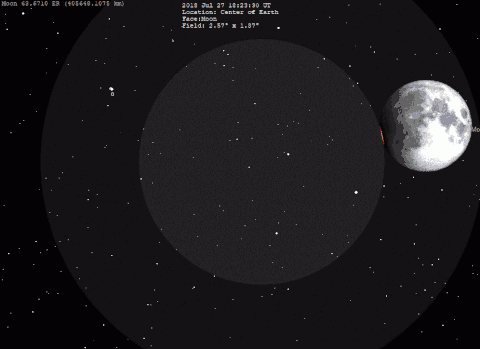
Visibility
.jpg.webp)

The lunar eclipse was completely visible over Eastern Africa, Southern Africa, Southern Asia and Central Asia, seen rising over South America, Western Africa, and Europe, and setting over Eastern Asia, and Australia.[10]
 View of earth from moon at greatest eclipse |
Map

Observations
 Animation of the eclipse from Athens, Greece
Animation of the eclipse from Athens, Greece Nanjing, China, 18:25 UTC
Nanjing, China, 18:25 UTC.jpg.webp) Asunción, Paraguay 19:10 UTC
Asunción, Paraguay 19:10 UTC Rethymnon, Greece 19:14 UTC
Rethymnon, Greece 19:14 UTC.jpg.webp) Johannesburg, South Africa, 19:16 UTC
Johannesburg, South Africa, 19:16 UTC Guangzhou, China, 19:20 UTC
Guangzhou, China, 19:20 UTC Limassol, Cyprus, 19:27 UTC
Limassol, Cyprus, 19:27 UTC Tashkent, Uzbekistan, 19:32 UTC
Tashkent, Uzbekistan, 19:32 UTC Jerusalem, Israel, 19:33 UTC
Jerusalem, Israel, 19:33 UTC.jpg.webp) Eclipse with Mars, Fukuoka, Japan, 19:46 UTC
Eclipse with Mars, Fukuoka, Japan, 19:46 UTC.jpg.webp) Cracow, Poland, 20:05 UTC
Cracow, Poland, 20:05 UTC Chelsea, Victoria, Australia, 20:07 UTC
Chelsea, Victoria, Australia, 20:07 UTC.jpg.webp) Tuen Mun, Hong Kong, 20:47 UTC
Tuen Mun, Hong Kong, 20:47 UTC.jpg.webp) Huittinen, Finland, 21:05 UTC
Huittinen, Finland, 21:05 UTC.jpg.webp) Graz, Austria, 21:12 UTC
Graz, Austria, 21:12 UTC_(42991774724).jpg.webp) Toulouse, France, 21:17 UTC
Toulouse, France, 21:17 UTC Berlin, Germany, 21:19 UTC
Berlin, Germany, 21:19 UTC.jpg.webp) Torino, Italy, 21:19 UTC
Torino, Italy, 21:19 UTC.jpg.webp) Hamburg, Germany, 21:23 UTC
Hamburg, Germany, 21:23 UTC Brastad, Sweden, 21:24 UTC
Brastad, Sweden, 21:24 UTC.jpg.webp) León, Spain, 21:27 UTC
León, Spain, 21:27 UTC Maximum from Banjarmasin, Indonesia, 20:21 UTC
Maximum from Banjarmasin, Indonesia, 20:21 UTC
Related eclipses
Eclipses of 2018
Lunar year series
| Lunar eclipse series sets from 2016–2020 | ||||||||
|---|---|---|---|---|---|---|---|---|
| Descending node | Ascending node | |||||||
| Saros | Date | Type Viewing |
Gamma | Saros | Date Viewing |
Type Chart |
Gamma | |
| 109 | 2016 Aug 18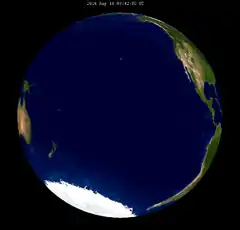 |
Penumbral |
1.5641 | 114 |
2017 Feb 11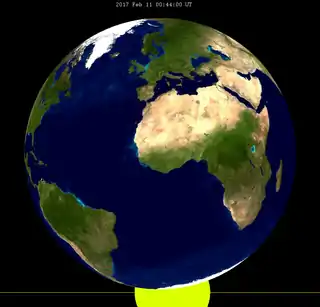 |
Penumbral |
-1.0255 | |
119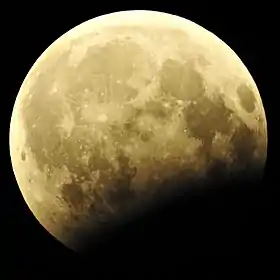 |
2017 Aug 07 |
Partial |
0.8669 | 124 |
2018 Jan 31 |
Total |
-0.3014 | |
129_(43696968392)_(cropped).jpg.webp) |
2018 Jul 27 |
Total |
0.1168 | 134_(cropped).jpg.webp) |
2019 Jan 21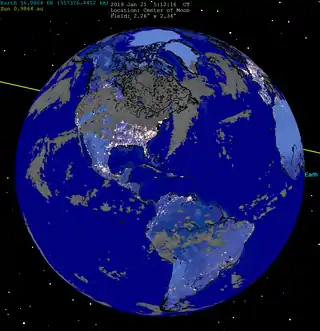 |
Total |
0.3684 | |
139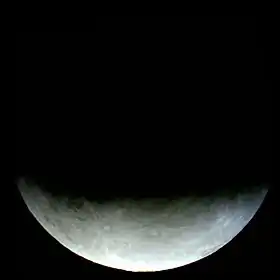 |
2019 Jul 16 |
Partial |
-0.6430 | 144 |
2020 Jan 10 |
Penumbral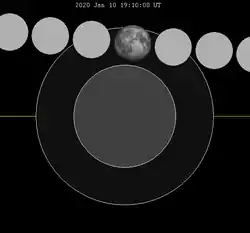 |
1.2406 | |
| 149 | 2020 Jul 05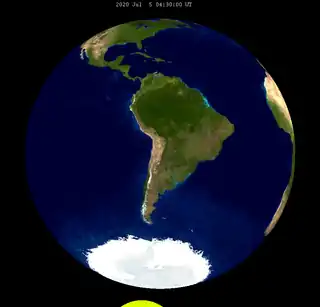 |
Penumbral |
-1.3639 | |||||
| Last set | 2016 Sep 16 | Last set | 2016 Mar 23 | |||||
| Next set | 2020 Jun 05 | Next set | 2020 Nov 30 | |||||
Saros series
Lunar saros series 129, repeating every 18 years and 11 days, containing 71 events, has 11 total lunar eclipses. The first total lunar eclipse of this series was on May 24, 1910, and last will be on September 8, 2090. The two longest occurrence of this series were on July 6, 1982 and July 16, 2000 when totality lasted 106 minutes.
| Greatest | First | |||
|---|---|---|---|---|
 The greatest eclipse of the series occurred on 2000 Jul 16, lasting 106 minutes. |
Penumbral | Partial | Total | Central |
| 1351 Jun 10 | 1513 Sep 15 | 1910 May 24 | 1946 Jun 14 | |
| Last | ||||
| Central | Total | Partial | Penumbral | |
| 2036 Aug 7 | 2090 Sep 8 | 2469 Apr 26 | 2613 Jul 24 | |
| 1910 May 24 | 1928 Jun 3 | 1946 Jun 14 | |||
 |
 |
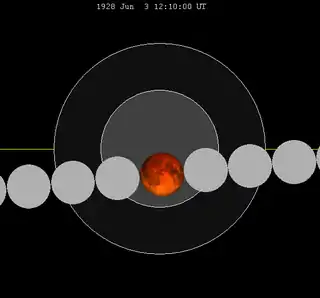 |
 |
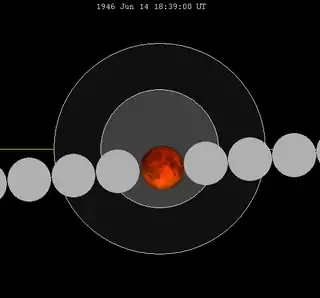 |
 |
| 1964 Jun 25 | 1982 Jul 6 | 2000 Jul 16 | |||
 |
 |
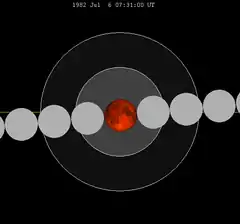 |
 |
 |
 |
| 2018 Jul 27 | 2036 Aug 7 | 2054 Aug 18 | |||
 |
 |
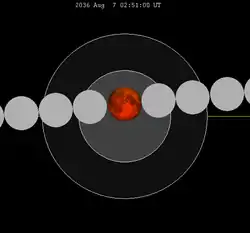 |
 |
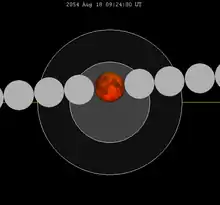 |
 |
| 2072 Aug 28 | 2090 Sep 8 | ||||
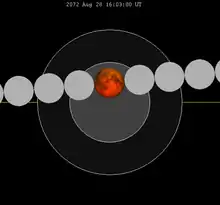 |
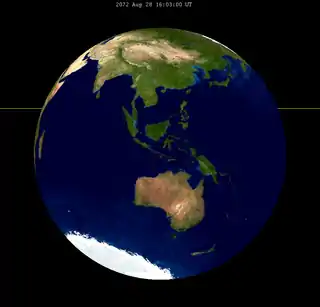 |
 |
 | ||
It last occurred on July 16, 2000 and will next occur on August 7, 2036.
This is the 38th member of Lunar Saros 129. The previous event was the July 2000 lunar eclipse. The next event is the August 2036 lunar eclipse. Lunar Saros 129 contains 11 total lunar eclipses between 1910 and 2090. Solar Saros 136 interleaves with this lunar saros with an event occurring every 9 years 5 days alternating between each saros series.
Half-Saros cycle
A lunar eclipse will be preceded and followed by solar eclipses by 9 years and 5.5 days (a half saros).[11] This lunar eclipse is related to two total solar eclipses of Solar Saros 136.
| July 22, 2009 | August 2, 2027 |
|---|---|
 |
 |
Related eclipses
See also
- List of lunar eclipses and List of 21st-century lunar eclipses
Notes
- "What Is a Micromoon?". Timeanddate.com. Stavanger, Norway: Time and Date AS. n.d. Retrieved 27 July 2018.
- Mosher, Dave; Gal, Shayanne (27 July 2018). "The longest total lunar eclipse in a century is about to happen — here's how Earth will color the moon blood-red". Business Insider. Retrieved 27 July 2018.
- McClure, Bruce (27 July 2018). "Century's Longest Lunar Eclipse July 27". EarthSky. Retrieved 27 July 2018.
- Space (29 December 2017). "In 2018 the longest lunar eclipse will take place in 100 years". Earth Chronicles. Retrieved 27 July 2018.
- Resnick, Brian (27 July 2018). "Watch: The longest 'blood moon' lunar eclipse of the century". Vox. Retrieved 27 July 2018.
- Nunamaker, Susan Sun (27 July 2018). "Century's Longest Lunar Eclipse, Blood Moon 2018, Today, Will Last 103 Minutes". Windermere Sun. Retrieved 27 July 2018.
- "Два редких астрономических явления можно будет наблюдать 27 июля". TASS (in Russian). 27 July 2018. Retrieved 27 July 2018.
- Lyons, Kate (27 July 2018). "Blood moon: All you need to know about this week's lunar eclipse". The Guardian. Retrieved 27 July 2018.
- Espenak, Fred; Meeus, Jean (27 July 2018). "Visual Appearance of Lunar Eclipses". NASA Eclipse Web Site. National Aeronautics and Space Administration. Retrieved 27 July 2018.
- "Eclipse Map — 27 July 2018 Total Lunar Eclipse".
- Mathematical Astronomy Morsels, Jean Meeus, p.110, Chapter 18, The half-saros
External links
| Wikimedia Commons has media related to Lunar eclipse of 2018 July 27. |
